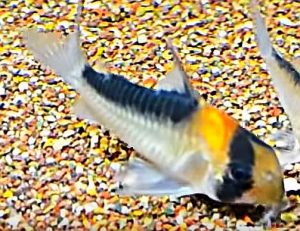Adolfo’s Cory (Corydoras Adolfoi) are a small peaceful Corydora species found in a small tributrary of the upper Rio Negro basin near São Gabriel da Cachoeira, Brazil’. Unsubstantiated sources report that it also occurs in the Rio Uaupés, a tributary 0f the Rio Negro in Colombia.
Adolfo’s Cory live in slow moving, tea colored blackwater tributaries and flooded forests of their range that are stained dark brown by organic chemicals that are the result of plant decomposition.
Like many other corydoras, Adolfo’s Cory is an air breather that has a highly vascularised intestine modified to
breathe atmospheric oxygen. This allows them to survive in oxygen depleted waters and is why they can be observed occasionally rising to the surface in the aquarium to take in a gulp of air.
Corydoras Adolfoi has stiff pectoral fin spines that can pierce human skin and a cause a painful sting from the mildly toxic secretions from the
axillary glands at the base of each spine.
They thrive in soft pristine waters with low conductivity and a pH of 4.0 to 6.0 along with dwarf Apistogramma cichilids, cmall characids, Pencil fish (lebiasinids), and coexist in large mixed schools of similarly colored Corydoras.
Adolfo’s Cory is only one of many Corydora species native to the rio Negro region that possess a color pattern with an oblique dark bar running along the dorsal surface of the body.
Adolfo’s Cory has a light colored lower body that gradually changes to a jet black on the upper half. They posses a black stripe over the eyes with a bright orange/gold blotch that starts just behind and above the eye and ends just before the front of the dorsal fin.
They have translucent fins that start with black at the base in the dorsal, anal, and caudal. Females grow larger than males and when sexually mature are noticeably rounder and broader bodied, especially when gravid.
Adolfo’s Cory are best kept in groups of at least 6 to 8 individuals in a planted aquarium of at least 29 gallons with a sand or fine rounded gravel substrate, some driftwood or bogwood as hiding places, and some dried or crushed Indian Almond Leaves
.
They require a good filtration system with regular water changes and although they need little water movement, are sensitive to adverse water quality. Driftwood branches and dried leaf litter provide beneficial microorganisms that become a secondary food source that is particularly useful for the fry when breeding Corydoras Adolfoi.
The tannins that are released by the decaying leaves in the tank simulate the natural habitat that Adolfo’s Corys are found in and produce beneficial chemicals that are believed to be a natural fungicide.
Like other Corydoras species, Corydoras Adolfoi are easy to breed in an aquarium environment. Place two males per female if possible into a well oxygenated breeding tank (a corner sponge filter is preferred), densely planted with fine leaved vegetation or furnished with spawning mops. Some partially decomposed Indian Almond leaves or other leaf litter on the bottom of the tank is recommended if the eggs are to remain in the breeding tank for hatching. If the eggs are removed to a rearing tank, use the same tank water and add a few drops of methylene blue
, or some crushed Indian Almond leaves
or an alder cone or two to prevent fungus development on the eggs.
The water in the breeding tank should be around 79° F and at the lower end of th pH range.
When the female is visibly gravid, perform a 70% water change with slightly cooler water and ramp up the oxygenation in the tank. Do this daily until the fish begin to spawn.
Corydoras Adolfoi are open water spawners and will attach one or two relatively large (2mm) sticky eggs to the plants, stones, or glass in the aquarium. Females can deposit several tens of eggs per spawn. Adults do not care for the eggs and may eat them, so remove either the adults or the eggs from the tank for rearing.
Depending on the water temperature, the eggs will hatch in about 3 to 4 days and fry will absorb their yolk sacs and become free swimming after another 4 days. At this point the fry can be fed infusoria, microworms, newly hatched baby brine shrimp, etc. until able to eat adult foods.
In their natural habitat, the Adolfo’s Cory is a foraging shoaling species that feed on small insects, benthic crustaceans, small worms, and decaying plant matter.
In an aquarium environment, they make a colorful cleanup addition to a Discus or community aquarium but should be fed a varied diet of sinking dried foods as well as live, frozen, or freeze dried bloodworms, Tubifex
, Daphnia, brine shrimp, etc. This species requires a varied diet to ensure they remain in optimum condition. They should never be expected to survive on only left overs from community tank residents.
Although the Adolfo’s Cory (Corydoras Adolfoi) is not common found in your local fish shop, tropical fish keeping enthusiasts can purchase them online, from auction or forum sites, eBay, or from special order at moderate prices.
Minimum Tank Size: 30 gallons
Care Level: Easy
Temperament: Peaceful, gregarious
Aquarium Hardiness: Hardy
Water Conditions: 68 – 79 °F, H 18-90 ppm, pH 4.0 – 7.0
Max. Size: 2.2″
Color Form: Black, Orange
Diet: Omnivore
Compatibility: Community tanks
Origin: Colombia
Family: Callichthyidae
Life Span: 5 years
Aquarist Experience Level: Beginner






